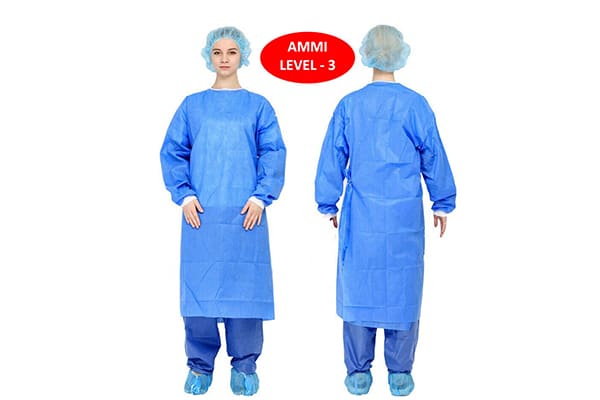Personal Protective Equipment (PPE) plays a crucial role in safeguarding healthcare professionals and patients from harmful pathogens. Among the key PPE items, isolation gowns stand out as essential barriers against the spread of infections, offering protection from various levels of exposure to fluids and contaminants.
Isolation gowns are often referred to as surgical gowns or cover gowns. They are designed to provide coverage to the front of the body and are secured by tying at the neck and waist. These gowns are instrumental in preventing fluids from reaching the wearer, ensuring safety during medical procedures or patient care activities. Depending on the level of exposure risk, these gowns are categorized into four distinct levels of protection.
The Association for the Advancement of Medical Instrumentation (AAMI) has set the standard for isolation gowns, categorizing them based on liquid barrier performance, with levels ranging from 1 to 4. Let’s explore these levels and understand how to choose the right gown for different environments.
What is AAMI?
AAMI stands for the Association for the Advancement of Medical Instrumentation. Recognized by the FDA, AAMI sets the standards for the protective qualities of medical gowns, including isolation and surgical gowns. Manufacturers follow these guidelines to ensure that their products meet specific protection criteria, ensuring that healthcare professionals are adequately protected during procedures.
The Four Levels of Isolation Gowns
The classification of isolation gowns is based on the degree of protection they provide against fluid penetration. Each level is designed for a different risk environment, making it important to select the appropriate gown depending on the task at hand.
Level 1 Isolation Gown
Level 1 gowns offer the lowest level of protection, intended for situations with minimal fluid exposure risk. These gowns are ideal for basic patient care activities such as routine check-ups and ward visits. They provide a basic barrier but are not suitable for intensive care settings or when dealing with blood draws.
Level 2 Isolation Gown
Level 2 gowns provide a moderate level of protection and are suitable for tasks like blood draws, suturing, or work in intensive care units (ICUs). These gowns are tested for their ability to prevent fluid splatter from penetrating the material and offer more protection than Level 1 gowns.
Level 3 Isolation Gown
Gowns in this category are designed for moderate-risk situations, such as in trauma units or during arterial blood draws. They provide better protection against fluid penetration compared to Levels 1 and 2. Level 3 gowns are often used in emergency rooms and are tested to ensure they prevent fluid soaking through the material.
Level 4 Isolation Gown
Level 4 gowns offer the highest level of protection and are used in high-risk environments like surgeries or when working with highly infectious diseases. These gowns are tested to withstand long-term fluid exposure and even prevent virus penetration for extended periods. Their high sterility makes them ideal for critical procedures and high-risk contamination environments.
Choosing the Right Isolation Gown for Your Needs
When selecting an isolation gown, it’s crucial to consider the environment and level of exposure to bodily fluids. For routine care in low-risk areas, a Level 1 or 2 gown may be sufficient. However, for surgeries or work with infectious diseases, Level 3 or 4 gowns should be prioritized to ensure maximum protection.
Isolation gowns are also essential in pandemic situations, where the risk of fluid transmission is high. Gowns used in these scenarios should meet AAMI standards and be paired with additional PPE, such as face masks and gloves, for comprehensive protection.
AAMI Level Gowns in Healthcare Settings
In low-risk environments, such as outpatient care or routine examinations, Level 1 and 2 gowns provide adequate protection. In contrast, Level 3 and 4 gowns are necessary for high-risk procedures, such as surgeries or tasks involving potential contact with infectious diseases.
For medical facilities, sourcing the right isolation gown is vital for staff and patient safety. Ensuring that the gowns meet AAMI standards guarantees that healthcare workers are well-protected in any situation, from low to high-risk environments.
Conclusion
Isolation gowns are an integral part of personal protective equipment in healthcare settings. Choosing the correct gown level, based on AAMI standards, ensures that healthcare professionals are protected according to the level of risk they encounter. Whether you need minimal protection for routine care or maximum barrier protection for surgical procedures, understanding these levels helps make informed decisions for safety in any medical environment.
Post time: 9月-18-2024






